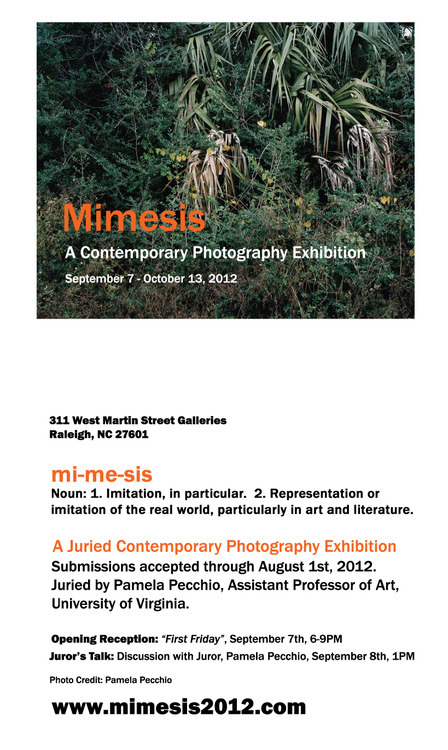
I have been selected to be in this exhibit,
which opens at the 311 West Martin Street Galleries

I have been selected to be in this exhibit,
which opens at the 311 West Martin Street Galleries

SUNDAY AFTERNOON SALON

Photo: © Bryce Lankard, Republican National Convention, 1988
It looks like we’re in store for another hot Sunday—all the reason to chill at the Sunday Afternoon Salon. It’s the perfect place
to relax with like-minded friends, look at photographs, and talk about photography. This Sunday, we are excited to have Brie Castell
and Heidi Gruner from Castell Photography as our special guests. Castell Photography is Asheville, NC’s only fine art photography
gallery and both Brie and Heidi have done wonders for the photography scene in the Asheville area. They will be here to promote their
upcoming photography competition and exhibition titled Road. The juror for Road will be W.H. Hunt, an avid and serious photography
collector, former New York gallery owner, and when it comes to photography, he’s one of the most knowledgeable people that I know. Also, Bryce Lankard has been working hard on Frank: In Focus, the two-month long festival of photography in the Triangle Area. The latest schedule of exhibitions and forums on photography is out and there’s definitely something for every photography lover. The Uptown
Charlotte security perimeter for the DNC has been decided and we’ll talk about where you can and cannot go to photograph what’s happening
on the streets. There should be a lot of photo opportunities since as many as 10,000 demonstrators could show up. The 10thAnniversary
Lucie Awards—“celebrating the greatest achievements in photography the world over”—have also been announced and we’ll take a look at this year’s winners (I’m happy to see that Arthur Tress will be honored for Achievement in Fine Art). And as always, feel free to share your own photographs with the group. The Sunday Afternoon Salon will be held once again at The Light Factory in the Art Studio on the third floor, #307 (when you enter Spirit Square from College Street, walk up the short flight of steps and enter the elevator to your left. Go to the third floor and exit left.
You’ll see the Art Studio at the end of the hall). Free to members of The Light Factory, the Salon happens the third Sunday of every month.
Attendees are welcome to bring food and/or drink.
When: Sunday, August 19, beginning at 2 PM
Where: The Light Factory, Spirit Square, 345 N. College Street
(meet in the third floor art studio, #307—see directions above)
(parking is available on the street or at the 7th Street Garage. You might also try the LYNX Light Rail)
Who: Free to members of The Light Factory
(For membership information, go to www.lightfactory.org)
If you are interested in presenting your work or would like more information, please call 704.804.7467
(Note: Please limit your images to a reasonable number so everyone will have a chance to share their work).
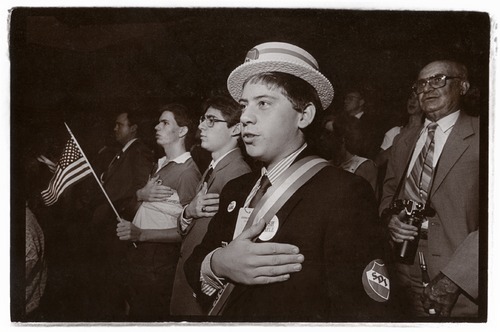
![]()
Sunday, Sept. 9 @ 2:30 pm
Framer’s Corner, 210 West Main St, Carrboro, NC 27510 919.929.3166
Donn will talk about his current exhibition “Four Photographic Essays.”
If you have come to this page via a Q code…congrats on being so tech savvy.
Some work from “Blink of an Eye” is included in the Changing Focus: The Image in Flux exhibit at Frank Gallery during the InFocus festival.
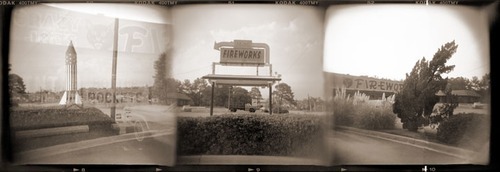
blink of an eye - a very short time (as the time it takes the eye to blink or the heart to beat); - an indefinitely short time.
Blink of an eye
and it’s gone.
This body of work examines moments and places we can often take for granted - those we think will always be around, and then, in the blink of an eye, can be gone.
This project is my personal response to the events surrounding both 9.11 and Hurricane Katrina. Having been saturated with images of destruction, the intent in “Blink of an Eye” is to examine a more psychological and emotional response to a sense of loss, dislocation and isolation. I have used toy cameras and the soft, gauzy look they provide in order to create images depicting more of a sense of nostalgia, tinged with sentimentality and even optimism.
I feel that this notion of loss can be applied to physical objects such as buildings or cities, but also to more ephemeral concepts such as summertime, mortality and youth. My photographs reflect these recurring themes through iconic childhood and leisure-time subjects such as playgrounds, carnivals and midways, such as the final days of Coney Island, quiet moments, and off-season vignettes. By occasionally using double exposures and image sequences arranged out of order I also want to cause a sense of discomfort and disruption.
Notes on the images: All the images were made using several Holga’s. These are cheap plastic toy cameras, and I have pushed and pulled the film, using overlapping multiple exposures on several. Once developed, I scan the negatives and create my final images using archival ink on Somerset Velvet paper.
I just finished teaching my first Toy Camera workshop at the ArtsCenter. I was lucky to have a very engaged and eager group. Not a single complaint when we did our first shooting hike in over 100 degree heat! I am awaiting some digital files from the class and will soon post a gallery of our work from this class.
My students pushed me as well. I was motivated to do some long overdue mods to some of my holgas, including a frankenstein number which converted one into a fisheye. Kept the nice strap and lens cap from the cannibalized camera because I loved that it had a warning…”Lens is not removable.” Ha! I have yet to put a roll through her but I have given her a name, Zebra Charlie Tango.
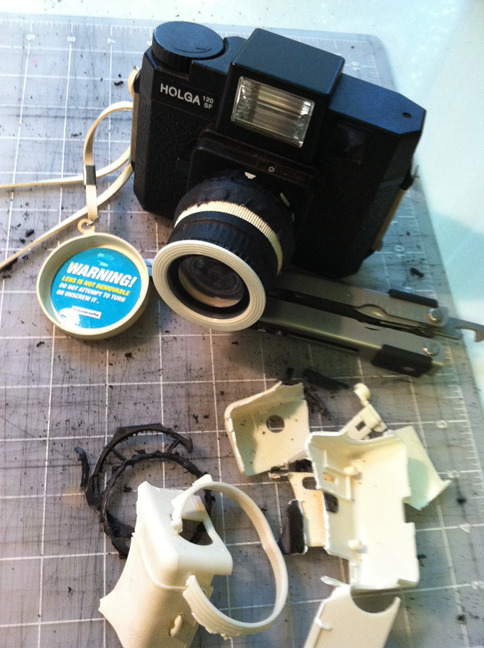
Franklin Street, North Facing, 1984
I did not even realize that Green Hill had posted this in reference to the Winter Show. An added bonus is that I can add this to the large collection of places that have misspelled my name.
Here is a link to a Flikr gallery that contains samples of my Cyanotypes and Anthrotypes.
The Cyanotype process was invented in 1842 by Sir John Herschel, an English astronomer and scientist. The process of cyanotype printing makes use of two chemicals. These are Potassium ferricyanide and Ammonium iron (III) citrate. Commonly a contact print is made by exposing in the sun. Exposed areas turn a beautiful Prussian blue due to a chemical reaction in the iron caused by UV light.
Just as in the gum bichromate process, several coatings may be applied to the print, which I have done using coatings with varied amounts of activator or freshness. Additionally some images have been soaked or bleached in tea or coffee and a various combinations of all the above. Cyanotypes are considered to be more or less permanent, but it is not recommended to keep them in bright sunlight. If the image does fade it is recommended to store them in a dark place for a time and the image will be restored.
I have a couple cyanotypes in this show doing double duty as a cheap sales pitch for folks to sign up for my cyanotype workshop, which starts next week!!!
PRERIVATIVE #4
Encaustic Constructions, circa 2003.
I suppose these aren’t strictly prerivatives, as I had certainly seen photo collage work and the use of encaustic wax before. The “Encaustic Constructions” project evolved from a previous body of work, “The Illuminated Shadow”, which centered on the abstractions and textures of human form and flesh. Initially I simply wantd to be able to make larger work and didn’t have access to a large printer or the means to pay for large prints. At the beginning I was simply “tiling” small prints and combining them using wax. But as is often the case, this new method led me to new ideas. The “Constructions” took the focus of line and texture from “Illuminated Shadow” even further by placing the same imagery in different contexts, combining them with text and three dimensional environments and by further deconstructing the human form into disconnected elements or overlapping forms.
This is the series which is represented at the “Last Beasts” show in Savannah listed below.
Little Beasts is excited to present its final group show, Last Beast, which will feature the work of over 20 local and international artists. The works touch on a variety of mediums, including paper cutout, lithography, oil painting, pastels, etchings, encaustic coated photography, and video works. The show explores the range of human experience, and through the variety of mediums, offers a look into the multitude of ways in which people observe and reconstruct their reality using different material and incorporeal components.
PRERIVATIVE #3
Photo Constructions. circa 1993
I believe this is the only example I have left of a set of mixed media photo constructions I created for a show at ICONS gallery around 1993. These used a lot of Liquid Light emulsion on a variety of materials such as Tin, Iron, Glass, and many were 3D constructions that used barbed wire, railroad spikes and other items. The structure of this piece “Caged Cajun” is actually a protective cover for an outdoor industrial light fixture.
PRERIVATIVE #2
Photo Resists, circa 1983 and 1993?
These are from an on again/off again series of experiments using photo resists. A resist can be almost any substance you can apply to photographic paper that prevents the chemical from making contact with the paper, resisting development. It can be anything like toothpaste, vaseline, lipstick and each will react in different ways. Some stick like glue and others are easily eroded by liquid. I also combined this with photograms, contact prints, printing through screens, and other techniques. Once the initial exposure is made and the paper is put through initial development and then fixed, the original development is essentially locked in. Then by repeating the development and either shaking the print to erode some resists, or wiping away stubborn ones, and occasionally also turning lights on and off to expose the paper again I found that I got very interesting patterns and tones and selective solarization and all kinds of fun stuff. I think maybe a couple of these were published in a University Arts Magazine, but I don’t think I ever showed them anywhere.
PRERIVATIVE #1
Keyhole Photography _”Desier in dormer” circa 1987?
I had the strange luck while living in New Orleans of discovering three different, naturally occurring camera obscuras.
The first was the double parlor of my first apartment, a ground floor, streetfront apartment on Bourbon Street. (I didn’t know any better and it was cheap) The shutters on the front window had been painted over so many times that only one tiny sliver of a gap remained for light to pass through. Early in the morning, when the sun would drench the opposite side of the street, we were treated to the entire scene, crisply sharp, upside down and backwards, of people walking down the sidewalk…for us along the ceiling.
The second occurence was when I had an assignment to do a portrait of two professors of architecture who took their classes on field trips to a large Sugar Mill and warehouse on the riverfront. This building is now the arts magnet high school NOCCA. While we were walking through the dark and cavernous rooms in search of a good location to shoot them, I started to get a feeling similar to being seasick. I stopped walking and stood still, and that is when I realized the floor was moving. Far overhead, a skylight that had long ago been covered in soot and dirt, had a tiny hole in the surface. What I was seeing on the floor were the briskly moving clouds in the sky outside, sweeping along underfoot and almost making me dizzy!
The final camera obscura was in my next apartment, an attic space in a grand old building on Royal Street in the lower quarter that I shared with my new girlfriend Desier. Our bedroom in a tiny eaves had an old door with an old-fashioned skeleton keyhole. The key was long gone and directly opposite was our kitchen, which was tucked into the tiny space by a dormer window. I noticed vague shapes on our bedroom wall whenever the door was closed. Hmmm. I found some electric tape and made the hole a bit smaller. The shapes got a bit sharper. A bit more tape and the window frame almost came into focus. I can work with this. I created a shutter/hinged flap that completely blocked the hole. Then I taped up two sheets of photo paper to the wall and my my ever-willing model Desier stand in the window. I made my first test exposure, put the paper back in a box and walked over to my tiny, sweaty darkroom in the adjoining eaves (more on that another time) and developed the paper. A few more tests and I had a mildly fuzzy image with Desier, our houseplants and even the Mardi Gras beads hanging in the window.
I had the extreme pleasure of going with Lori Vrba to visit Frank Konhaus and his outrageous photography collection at the beautiful home that he and his wife created here in the heart of Chapel Hill. Frank is a fine photographer himself, but his photography collection was simply overwhelming. His joy in this work is readily apparent and quite contagious. He has amazing pieces scattered throughout their well-appointed and architecturally stunning house as well as a separate gallery dedicated to a specific artist. While Lori busied herself scribbling down the names of artists she wanted to learn more about, I mostly stood around slack-jawed.
The Konhaus family are great supporters of the arts and many deserving causes, but one unique thing they do at the home they call “Cassilhaus” is an artist-in-residence program. Artists of a variety of disciplines spend time in the guest quarters, doing whatever they please, the only requirement being to do one event that engages the local community. I realized quickly that I could do an entire multi-week residency just to have the time to digest the work in Frank’s collection. I guess my part of that pipe dream would be to then speak about the work????
One of the aspects of contemporary photography that fascinates me is the seemingly unending variations in which artists are using photography. Ways that break out of the traditional photo behind a matte in a simple frame style, mixing photography with so many other media, expanding into 3 dimensional objects, pushing and pulling and twisting the conventional processes. It reaffirms my belief that I work in the most creative and expressive medium, one filled with mind-boggling talent. It brought to mind the joy I had in blindly experimenting, certainly at the early stages of my photographic discoveries, but really a desire that has recurred throughout my career whenever I get the urge to break out of that straight, street photographer mentality. Frank and his wife have coined a term, “Prerivative”, which I adore. In a nutshell, I understand it to mean —work by an artist done in a unique, fresh new style that didn’t really break through and gain attention until another artist takes that method to new heights. Perhaps then attuned viewers may look back and say “Oh, so and so was kinda doing something like that back when.” Delightful. For me, because I am just another self-absorbed artist, some of the work in Frank’s collection made me think of all those experiments I did. I see brilliant work by an artist and think, oh my goodness, I recognize that as a possible conclusion to that path that I started and abandoned. It gives me great joy to see how the minds of such creative people have carried these ideas to such heights. For myself, I recall that my own sojourns were sometimes just to see if I COULD do sometthing, if it were possible, if I could do it in the darkroom without causing brain damage. I wasn’t always successful, as many will attest to, no doubt. Occasionally I would do enough of this work for it to make sense to show it somewhere. Far more frequently, it was just for me. Once I had figured out how to do something then I was done… off to the next thing.
When I mentioned to Frank that I had this “art hangover”, his advice was that the only cure was to look at more photography. I figured what better while I was thusly inspired than to unearth some of these experiments and look at them again. For better or worse, I will share a few of these.
Had a nice afternoon of talking books and book projects with Vrba. We are cooking up some schemes. We swapped a few books and one of them, “Wolf’s Honey” struck me in a number of ways. On an ironic note, Vojtech began his path of photographic discovery by forming a group called “the Czech Parallax Group” which I have an obvious affinity for, and to discover that many of his subjects were fellow photographers from this group. I guess lots of czech girls carry cameras. The text in the book referred to his ultimate focus on the banal and mundane truths of his life. I am struck with the notion that so many of my images that ended up on my cutting room floor over the years, would find a new audience in today’s aesthetic.
I enjoyed picking out running themes and subjects that reappear throughout his visual narratives. In no particular order:
for all his attention to the mundane, he makes it all look very sensuous. 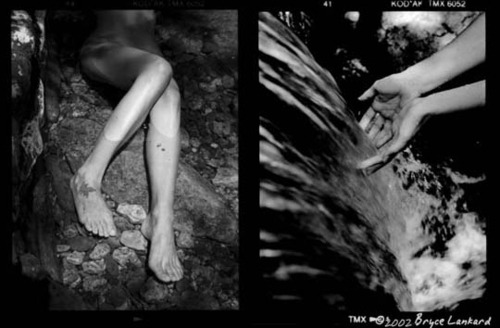
and it inspired me to share this image of mine.